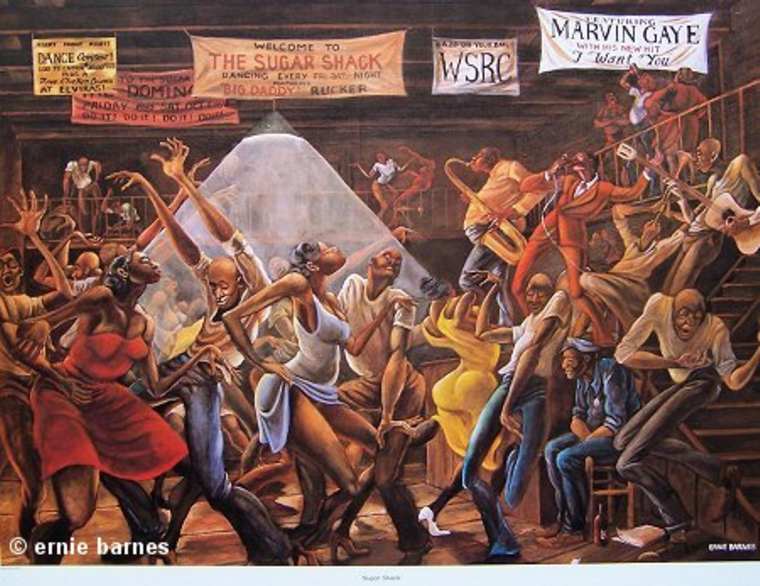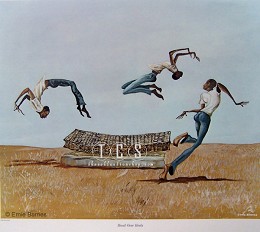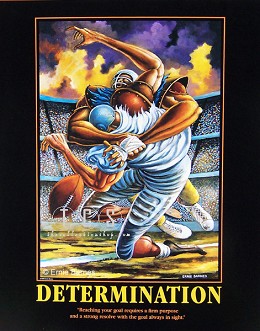
| THE HANDSTAND | MAY2009 |


Ernie Barnes dies
at 70; pro football player, successful painter
The official artist of the 1984
Olympics in
By Elaine Woo
April 30, 2009
Ernie Barnes, a former professional
football player who became a successful figurative
painter, known for depictions of  athletes and ordinary people
whose muscled, elongated forms express physical and
spiritual struggles, died Monday at Cedars-Sinai Medical
Center in Los Angeles. He was 70.
athletes and ordinary people
whose muscled, elongated forms express physical and
spiritual struggles, died Monday at Cedars-Sinai Medical
Center in Los Angeles. He was 70.
His death was caused by complications of a rare blood
disorder, according to his longtime assistant, Luz
Rodriguez.
Barnes was a
child of the segregated South who transcended racial
barriers to play for the Denver Broncos and San Diego
Chargers before pursuing his real dream: to be an artist.
He became the official artist of the 1984 Olympic Games
in







His style, which critics have
described as neo-Mannerist, became familiar to a prime-time
television audience in the mid-1970s when producer Norman
Lear hired Barnes to "ghost" the paintings by
the Jimmie Walker character "J.J." in the
groundbreaking African American sitcom "Good Times."
As the backdrop for the show's closing credits, Lear used
Barnes' 1971 painting "Sugar Shack," his most
famous work. Singer Marvin Gaye later adapted the
painting as the cover art for his 1976 album, "I
Want You."
"Sugar Shack" shows a Brueghel-like mass of
bodies, writhing and jumping to the rhythms in a black
jazz club. There is joy,  tension
and despair in the canvas, which Barnes once said was
inspired by a memory of being barred from attending a
dance when he was a child. As in nearly all of his
paintings, the subjects' eyes are closed, a reflection of
the artist's oft-stated belief that "we are blind to
each other's humanity."
tension
and despair in the canvas, which Barnes once said was
inspired by a memory of being barred from attending a
dance when he was a child. As in nearly all of his
paintings, the subjects' eyes are closed, a reflection of
the artist's oft-stated belief that "we are blind to
each other's humanity."
Singer-songwriter Bill Withers, who was close to Barnes
during the last decade of his life, said the artist often
spoke of wanting to educate people through his art.
"He meant getting people to look past the
superficial into the real vulnerable parts of themselves,"
said Withers, for whom Barnes completed his last major
commission, a painting inspired by Withers' 1971 hit
"Grandma's Hands." "He wanted to help
people peel away that layer of protection that we all
wear to ward off any intrusion into our real private
thoughts. He didn't mind people looking deeper into him.
I found that fascinating."
Barnes was born into a working-class family in Durham, N.C.,
on July 15, 1938. His father was a shipping clerk for a
large tobacco company, and his mother was a domestic for
a wealthy attorney. She brought home books and records
that her employer no longer wanted and used them to
broaden the cultural horizons of her three sons. She
encouraged them to draw pictures from their imaginations
instead of using coloring books. The shy and overweight
Ernie began drawing to escape from the taunts of his
schoolmates.
He was still chubbier than most kids when he reached high
school, but a teacher there helped him turn his size into
advantage.  He started lifting
weights, lost his extra pounds and began excelling on the
playing field. He became captain of the football team and
by graduation had scholarship offers from 26 colleges.
He started lifting
weights, lost his extra pounds and began excelling on the
playing field. He became captain of the football team and
by graduation had scholarship offers from 26 colleges.
He chose North Carolina College (now North Carolina
Central University), a historically black institution in
Durham, where he played football and majored in art. He
left before graduating in 1960 to turn pro. A 6-foot-3,
250-pound offensive guard, he played for a succession of
American Football League teams, including the Chargers
and the Broncos, for the next five years.
He had kept up with his art when he was playing football,
sketching fellow players, who nicknamed him "Big
Rembrandt." With little money and a family to
support when he left the game, he took a gamble and flew
to Los Angeles with several of his canvases and carried
them on foot several miles to the office of Chargers co-owner
Barron Hilton, who paid him $1,000 for a painting.
 After a brief stint as the AFL's
official artist, he met with New York Jets owner Sonny
Werblin, who offered to pay him $15,500 -- $1,000 more
than Barnes had earned in his last season in football --
to develop his skills as a painter for a year. Werblin
was so impressed with Barnes' work that he arranged a
showing for critics at a New York gallery.
After a brief stint as the AFL's
official artist, he met with New York Jets owner Sonny
Werblin, who offered to pay him $15,500 -- $1,000 more
than Barnes had earned in his last season in football --
to develop his skills as a painter for a year. Werblin
was so impressed with Barnes' work that he arranged a
showing for critics at a New York gallery.
Some critics compared him to George Bellows, the American
painter known for his masterful depictions of boxers in
the ring.
Soon Barnes was winning commissions from entertainers
such as Harry Belafonte, Flip Wilson and Charlton Heston.
His works from this period were often commentaries on the
brutality of professional football, depicting players
with fangs and other grotesque features. "I was
reaching for the absurdity of what men can be turned into
with football as an excuse," he told Sports
Illustrated in 1984.
Other paintings captured the powerful grace of youths
playing pickup basketball and the exhaustion of a runner
after a race. His series of Olympics posters were "the
finest, most effective and moving tribute to the Olympics
since the Greeks stopped painting their athletes . . . on
black or red grounds," critic Frank Getlein wrote in
a 1989 essay.
Barnes began to expand his subject matter in the early
1970s when he moved to the Fairfax district of Los
Angeles.
Observing the tight-knit Jewish neighborhood provoked in
him a new awareness of black culture and everyday life,
reflected  in "Sugar Shack" and a
traveling exhibition called "The Beauty of the
Ghetto." One of the stops on the tour was the North
Carolina Museum of Art, where years earlier a museum
docent had told Barnes "that black people didn't
express themselves as artists."
in "Sugar Shack" and a
traveling exhibition called "The Beauty of the
Ghetto." One of the stops on the tour was the North
Carolina Museum of Art, where years earlier a museum
docent had told Barnes "that black people didn't
express themselves as artists."
A longtime resident of Studio City, Barnes, who was
married three times, is survived by his wife of 25 years,
Bernie; five children, Sean, Deidre, Erin and Paige, all
of Los Angeles, and Michael of Virginia Beach, Va.; and a
brother, James, of Durham.
A private memorial service will be held at a later date.
Memorial donations may be sent to Hillsides Home for
Children, 940 Avenue 64, Pasadena, CA 91105.
Courtesy of Mikal Muhammad dcy2kinfo@juno.com<dcy2kinfo@juno.com>;
From: Watford, Charles (HHS)
Sent: Monday, May 04, 2009

ARTIST STATEMENT: “From
the beginning, I viewed this painting as a classical
composition of both symbolic and spiritual competition. I
had to be conscious of the symbolism of the game for the
participant as well as the observer. It takes the game
out of the physical rivalry and into the larger context
of the spiritual. The lower portion reflects the
spontaneity of a “pick up game,” the way it may
have been in some part of the country in 1946. Revealed
in the sky above the players is the unfolding of the
dream, an ascension into basketball heaven. The
exuberance of the fans, media and pundits are all part of
the game. The upper portion reveals the way it is today;
the world coming to the NBA. The oval top is reminiscent
of the Gothic arch of cathedrals and Renaissance
architecture, which reinforces the concept of an
aspiration to an ideal goal. From NBA, I created the
mythological “Neba,” Goddess of Basketball. She
carries the championship trophy while holding the rim for
a “Jordanesque” figure about to dunk the ball.
To carry the NBA logo, I employed the use of cherubs,
characteristically portrayed in Renaissance and
mythological art to connote the ideal of supreme
achievement.”